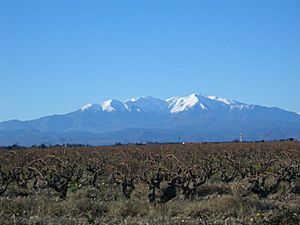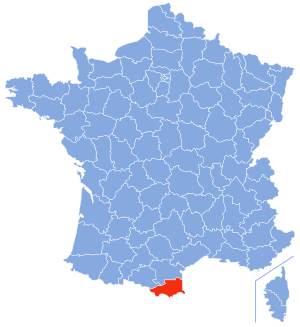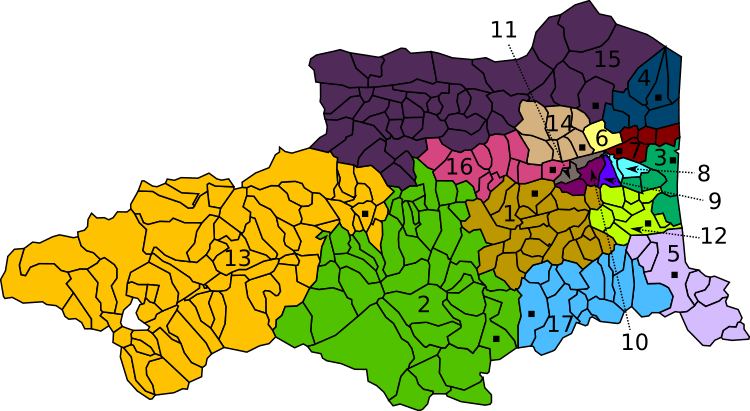Pyrénées-Orientales facts for kids
Quick facts for kids
Pyrénées-Orientales
|
|||
|---|---|---|---|

Le Canigou mountain, Pyrénées-Orientales
|
|||
|
|||

Location of Pyrénées-Orientales in France
|
|||
| Country | France | ||
| Region | Occitanie | ||
| Prefecture | Perpignan | ||
| Subprefectures | Céret Prades |
||
| Area | |||
| • Total | 4,116 km2 (1,589 sq mi) | ||
| Population
(2012)
|
|||
| • Total | 457,793 | ||
| • Rank | 54th | ||
| • Density | 111.223/km2 (288.07/sq mi) | ||
| Demonym(s) | Pyrénaliens, Pyrénaliennes | ||
| Time zone | UTC+1 (CET) | ||
| • Summer (DST) | UTC+2 (CEST) | ||
| ISO 3166 code | FR-66 | ||
| Arrondissements | 3 | ||
| Cantons | 17 | ||
| Communes | 226 | ||
| Website | http://www.cg66.fr | ||
Pyrénées-Orientales (which means Eastern Pyrenees in English) is a department in the Occitanie region of southern France. It is located right next to the northern Spanish border and the Mediterranean Sea.
This department is made up of two main historical areas. Most of it is the Catalan-speaking area called Roussillon. This area includes smaller parts like Roussillon (modern), Haute Cerdagne (or Cerdagne), Conflent, Vallespir, and Capcir. The other part is Fenouillèdes, which is a smaller area where Occitan was historically spoken.
Contents
History of Pyrénées-Orientales
Before the year 1659, most of what is now Pyrénées-Orientales was part of the Principality of Catalonia. This area belonged to the Kingdom of Spain. Because of this, most people in the region historically spoke Catalan. Even today, this part of France is sometimes called Northern Catalonia.
The Pyrénées-Orientales department was officially created in 1790. This happened during the French Revolution, when France was divided into new departments. These new departments replaced the older provinces. Pyrénées-Orientales was formed from the old province of Roussillon and a small area called Fenouillèdes. Fenouillèdes used to be on the southern edge of a region called Languedoc.
Geography and Landscape
Pyrénées-Orientales covers an area of 4,116 square kilometers (1,589 square miles). It shares its borders with several places. To the north, it has the department of Aude. To the east, you'll find the Mediterranean Sea. To the south, it borders Spain. Finally, to the west, it is next to Andorra and the department of Ariège.
 |
Aude |  |
||
| Andorra and Ariège | Mediterranean Sea | |||
| Spain (Catalonia) |
Mountains and Rivers
The department is mostly covered by the Pyrenees mountain range. The highest mountain here is Pic Carlit, which stands 2,921 meters (9,583 feet) tall. The most famous mountain in the department is Le Canigou, which is 2,784 meters (9,134 feet) high.
There are three main rivers that flow through the department. From north to south, they are the Agly, the Têt, and the Tech. The Têt is the largest river in the department. The Agly river starts in the Corbières hills, which are in the southern part of the Aude department. The Têt and Tech rivers both start in the Pyrenees mountains. All three rivers flow into the eastern Plain of Roussillon before emptying into the Mediterranean Sea.
Most of the people in Pyrénées-Orientales live in the Plain of Roussillon. This area also has most of the agricultural production, even though it only makes up about 30% of the department's total area.
Llívia: A Spanish Town in France
There is a unique town called Llívia. It is part of the province of Girona in Catalonia, Spain. What makes it special is that it is a Spanish exclave. This means it is a piece of Spanish territory completely surrounded by French land.
Administration and Divisions
The Pyrénées-Orientales department is managed by the General Council of the Pyrénées-Orientales. This council is located in Perpignan. The department is part of the larger Occitanie region in France.
Local Divisions
The area is traditionally divided into smaller regions called comarques. Five of these comarques are historically Catalan-speaking. These are French Cerdagne, Capcir, Conflent, Roussillon, and Vallespir. One comarque, Fenouillèdes, is historically Occitan-speaking.
The Pyrénées-Orientales department is divided into 3 arrondissements (which are like districts). It also has 17 cantons and 226 communes (which are like local towns or municipalities).
| INSEE code |
Arrondissement | Capital | Population (2012) |
Area (km²) |
Density (Inh./km²) |
Communes |
|---|---|---|---|---|---|---|
| 661 | Céret | Céret | 72,338 | 954 | 75.8 | 40 |
| 662 | Perpignan | Perpignan | 342,661 | 1,317 | 260.2 | 86 |
| 663 | Prades | Prades | 42,794 | 1,845 | 23.2 | 100 |
Here is a list of the 17 cantons in Pyrénées-Orientales. These were reorganized in March 2015:
- Les Aspres
- Le Canigou
- La Côte Sableuse
- La Côte Salanquaise
- La Côte Vermeille
- Perpignan-1
- Perpignan-2
- Perpignan-3
- Perpignan-4
- Perpignan-5
- Perpignan-6
- La Plaine d'Illibéris
- Les Pyrénées catalanes
- Le Ribéral
- La Vallée de la Têt
- La Vallée de l'Agly
- Vallespir-Albères

1- Les Aspres, 2- Le Canigou, 3- La Côte sableuse, 4- La Côte salanquaise, 5- La Côte Vermeille, 6- Perpignan-1, 7- Perpignan-2, 8- Perpignan-3, 9- Perpignan-4, 10- Perpignan-5, 11- Perpignan-6, 12- La Plaine d'Illibéris, 13- Les Pyrénées catalanes, 14- Le Ribéral, 15- La Vallée de l'Agly, 16- La Vallée de la Têt, 17- Vallespir-Albères
Population and Languages
In 2012, Pyrénées-Orientales had a population of 457,793 people. This means there were about 111 people living per square kilometer. The arrondissement of Perpignan is the largest by far, with 342,661 residents. The other two, Céret and Prades, have 72,338 and 42,794 people respectively.
The most important city in the department is Perpignan, which had 120,489 people in 2012. Other notable cities include Canet-en-Roussillon (12,602 people), Saint-Estève (11,362 people), Saint-Cyprien (10,552 people), and Argeles-sur-Mer (9,901 people).
The people who live in Pyrénées-Orientales are called Pyrénaliens (for men) or Pyrénaliennes (for women) in French. They are also often called Catalans.
Almost everyone in the department speaks French. However, Catalan and Occitan are also spoken by many people. It is estimated that more than a quarter of the population speaks these minority languages. More than 40% of the people understand them.
On December 10, 2007, the General Council of the Pyrénées-Orientales officially recognized Catalan as a regional language. However, French is still the only official language in France, according to the country's Constitution.
Climate in Pyrénées-Orientales
The department experiences three main types of climate, according to the Köppen climate classification:
- Csa - This is a Mediterranean climate with hot summers.
- Cfa - This is a humid subtropical climate with hot summers.
- Cfb - This is an oceanic climate with mild summers.
| Climate data for Perpignan, Pyrénées-Orientales, France | |||||||||||||
|---|---|---|---|---|---|---|---|---|---|---|---|---|---|
| Month | Jan | Feb | Mar | Apr | May | Jun | Jul | Aug | Sep | Oct | Nov | Dec | Year |
| Daily mean °C (°F) | 8 (46) |
8 (46) |
11 (52) |
13 (55) |
16 (61) |
20 (68) |
23 (73) |
23 (73) |
20 (68) |
16 (61) |
11 (52) |
9 (48) |
15 (59) |
| Average rainfall mm (inches) | 50 (2.0) |
40 (1.6) |
50 (2.0) |
40 (1.6) |
50 (2.0) |
30 (1.2) |
20 (0.8) |
20 (0.8) |
50 (2.0) |
70 (2.8) |
50 (2.0) |
50 (2.0) |
520 (20.8) |
| Source: Weatherbase.com [1] | |||||||||||||
Economy and Tourism
Pyrénées-Orientales is well-known for its wine production. It is also a popular place for tourists to visit.
The area is famous for its wine, especially red grape varieties. These grapes are grown all over the department.
Interesting Places to Visit
Here are some interesting places you might want to visit:
- Prades (also known as Prada de Conflent in Catalan) - This is where the Catalan Summer University is held.
- Banyuls-sur-Mer (or Banyuls de la Marenda in Catalan) - This town is famous for its wines.
- Prats de Molló - This town has an important defensive castle from the 17th century. It faces south towards the Pyrenees mountains.
- Salses - This town features a significant defensive castle from the 16th century. It was built on the old border with Spain.
Gallery
-
Martin-du-Canigou abbey
-
The "organ" of Ille-sur-Têt
Related Pages
- Northern Catalonia
- Arrondissements of the Pyrénées-Orientales department
- Communes of the Pyrénées-Orientales department
See also
 In Spanish: Pirineos Orientales para niños
In Spanish: Pirineos Orientales para niños













